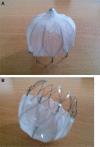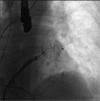Novel nonpharmacologic approaches for stroke prevention in atrial fibrillation: results from clinical trials
- PMID: 25678828
- PMCID: PMC4319717
- DOI: 10.2147/MDER.S70672
Novel nonpharmacologic approaches for stroke prevention in atrial fibrillation: results from clinical trials
Abstract
Atrial fibrillation (AF), the most common cardiac arrhythmia, confers a 5-fold risk of stroke that increases to 17-fold when associated with mitral stenosis. At this time, the most effective long-term solution to protect patients from stroke and thromboembolism is oral anticoagulation, either with vitamin K antagonists (VKAs) or a novel oral anticoagulant (NOAC). Despite the significant benefits they confer, both VKAs and NOACs are underused because of their increased potential for bleeding, and VKAs are underused because of their narrow therapeutic range, need for regular international normalized ratio checks, and interactions with food or medications. In patients with nonvalvular AF, approximately 90% of strokes originate from the left atrial appendage (LAA); in patients with rheumatic mitral valve disease, many patients (60%) have strokes that originate from the left atrium itself. Surgical LAA amputation or closure, although widely used to reduce stroke risk in association with cardiac surgery, is not currently performed as a stand-alone operation for stroke risk reduction because of its invasiveness. Percutaneous LAA closure, as an alternative to anticoagulation, has been increasingly used during the last decade in an effort to reduce stroke risk in nonvalvular AF. Several devices have been introduced during this time, of which one has demonstrated noninferiority compared with warfarin in a randomized controlled trial. This review describes the available technologies for percutaneous LAA closure, as well as a summary of the published trials concerning their safety and efficacy in reducing stroke risk in AF.
Keywords: CHADS; atrial fibrillation; left atrial appendage closure.
Figures




References
-
- Camm AJ, Kirchhof P, Lip GY, et al. European Heart Rhythm Association; European Association for Cardio-Thoracic Surgery Guidelines for the management of atrial fibrillation: the Task Force for the Management of Atrial Fibrillation of the European Society of Cardiology (ESC) Eur Heart J. 2010;31(19):2369–2429. - PubMed
-
- Sanna T, Diener HC, Passman RS, et al. CRYSTAL AF Investigators Cryptogenic stroke and underlying atrial fibrillation. N Engl J Med. 2014;370(26):2478–2486. - PubMed
-
- Mohammed I, Mohmand-Borkowski A, Burke JF, Kowey PR. Stroke prevention in atrial fibrillation. J Cardiovasc Med (Hagerstown) 2012;13(2):73–85. - PubMed
-
- Hart RG, Pearce LA, Aguilar MI. Meta-analysis: antithrombotic therapy to prevent stroke in patients who have nonvalvular atrial fibrillation. Ann Intern Med. 2007;146(12):857–867. - PubMed
Publication types
LinkOut - more resources
Full Text Sources

